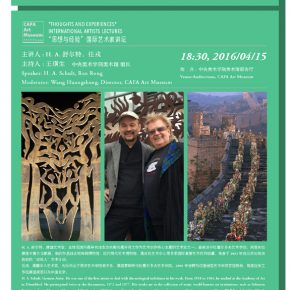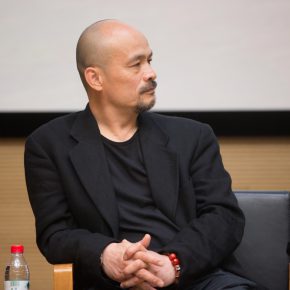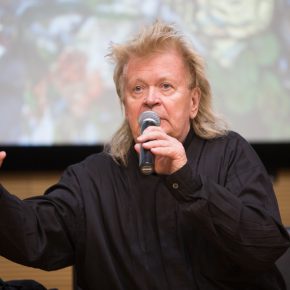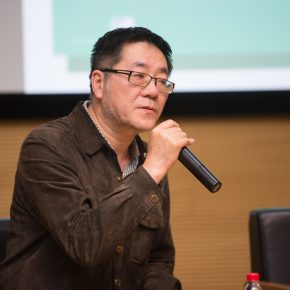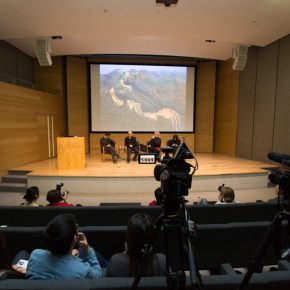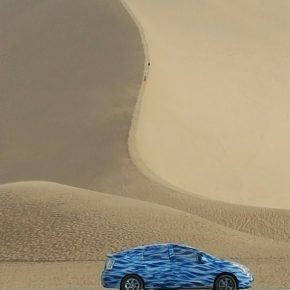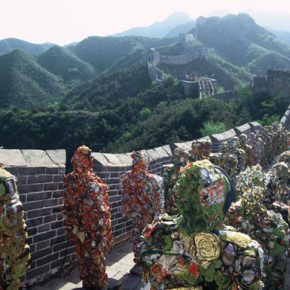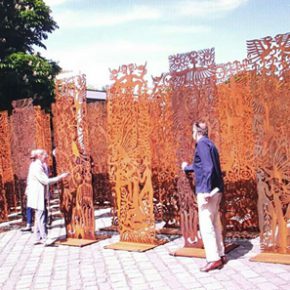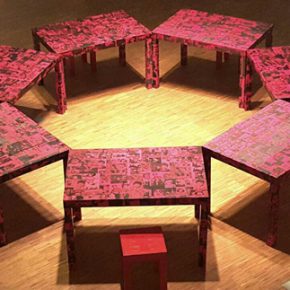
On the evening of April 15, 2016, the lecture entitled “We Are Environmental People – CAFAM ‘Thoughts and Experiences’ International Artists Lectures” was held at the Auditorium, CAFA Art Museum. It was hosted by Wang Huangsheng, Director, CAFA Art Museum, invited German artist H. A. Schulte, and German Chinese artist Ren Rong so as to discuss the issues of “the human beings and living space, the art and environment”.
H.A. Schulte and Ren Rong both graduated from the Kunst Akademie Düsseldorf, Germany, and have for a long time expressed their interest in the ecological environmental problems in their different forms of artistic language. Different cultural backgrounds and the same attention make both the Chinese and German artists become attracted to each other in art formation. In April 2015, the ’ “Blue” art project cooperated by these two artists started: they drove from Paris to Beijing, via 35 cities in different countries, to conduct the artistic creation through a “field visit, survival experience, collection samples”, and finally arrived in Beijing on April 15, 2016, and the two artists brought the freshest of their exchange experiences to this lecture.
At the beginning of the lecture, Wang Huangsheng recalled that H.A. Schulte presented the large-scale installation of his “Great Wall People” of his "Trash People" project on the Great Wall in Beijing in 2001, using all kinds of metal scrap materials to make 1000 “trash people” which formed a “spectacular junk art scene”. Since then, Schulte was known by Chinese people as “avant-garde artist” and “environmental thematic artist”, through the sharp problem consciousness and strong artistic language to affect Chinese contemporary artists.
When Schulte was questioned about the artistic concept, he said that, “Many artists place life on the shelf or the wall, while my work makes art return come alive. Art could not directly impact on politics, medical treatment and war, but it could affect the audience who really had the ability for action and change, which was the responsibility of art.
The Art as the “Hammer”
The ongoing “Blue Action” is coming to its end in Beijing, after the long operating process, Schulte and Ren Rong collected local water samples in each city, observing them through a microscope and taking photos of them, “allowing the nature of self-emerge”. After the action, the works created by the water examination will be on display at the art museums in many countries, and the water sample images which are symbols of the “flowing” water, would also showcase the consciousness of the water crisis and environmental protection as the shows flow from country to country.
Someone once compared the art to the “political hammer”, however, in the opinion of Schulte, the art itself should not be controlled and abused, the problematic consciousness and keen sense of touch created an inner strength, and the last barrier to keep freedom, the social openness could be measured by the artists’ degrees of freedom offered by society.
As early as the 1960s, Schulte started continuing to pay close attention to the increasing imbalanced ecological environment, and even issued an alert towards the political authorities: One day, the environment will determine the politics. Yet people still chose “consumption” as the “God”, the booming pop art was the artistic reflection of the social “materialistic” state at that time. Then the idea that the art should become a “hammer” developed in the mind of Schulte. In the following decades, Schulte created performance art and installation art from waste to mock the consumers’ society and he emphasized on the deteriorating relation between man and nature. He considered pop art as a social “drug”, the anesthesia of people’s environmental consciousness, while art should draw on the critical thinking power from life, through the exaggerated formal language to evoke people’s correct consciousness.
Standing in the West to Understand China
Schulte started to focus on China in the 1980s and he saw the rapid economic and cultural development in China, but he also found the destructive power of the development from the perspective of onlookers. In the journey of “Blue Action” the Chinese part, the tiny spring of the desert and the eastern Beijing-Hangzhou Canal made him feel the contrast between landscapes and the strong tension of man and nature. Recommended by Ren Rong, they passed by Yinchuan, Yan’an, Xi’an and other cities, and Schulte went deep into contemporary China from a variety of experienced perspectives including the geographical environment, living condition, peoples’ history. The “Blue Action” started from Paris, to interconnect Chinese and Western culture from the dual dimensions of space and time.
Ren Rong graduated from the Nanjing University of the Arts in 1986, and studied overseas in Kunst Akademie Düsseldorf, from that time has remained living and working in Germany. In the 1980s, Chinese art and culture became pluralistic and open under the influence of the west, but Ren Rong was a traditional rebel and he has learned from the western concepts, so he chose to leave the motherland. However, after he entered the western culture, he suddenly felt the uniqueness and complexity of Chinese traditional culture and history, the westerners feared and worshiped Chinese culture which also made him re-examine the art form bred by his own culture, the use of a new eye to care for both the familiar and strange cultural form. In the “Blue Action”, Ren Rong retraces the ancient Silk Road to review the constantly developing cultural memories in the process of his growth, looking for the plain cultural form of “the man as an integral part of nature” from the real folk life at the same time.
Concerning Chinese contemporary art, Schulte thought China had a very profound traditional culture, so Chinese contemporary artists should not only make their art become the “Chinese medicine” to cure the Chinese society and ideology, and also use new technologies and media to find a new direction in language with a traditional cultural background, to continue the tradition by perseverance.
In the final Q & A section, Schulte said his creative idea and Boyce’s stood in two opposite directions on the same philosophical dimension, namely commonly focusing on the problem of man and nature, but Boyce’s works was an enclosed artistic language which required an in-depth interpretation of thought and his work was in pursuit of the understanding effect of seeing at a glance through the language.
Text by Wei Xiankun, Photo by Yang Yanyuan/CAFA ART INFO
Translated by Chen Peihua and edited by Sue/CAFA ART INFO


